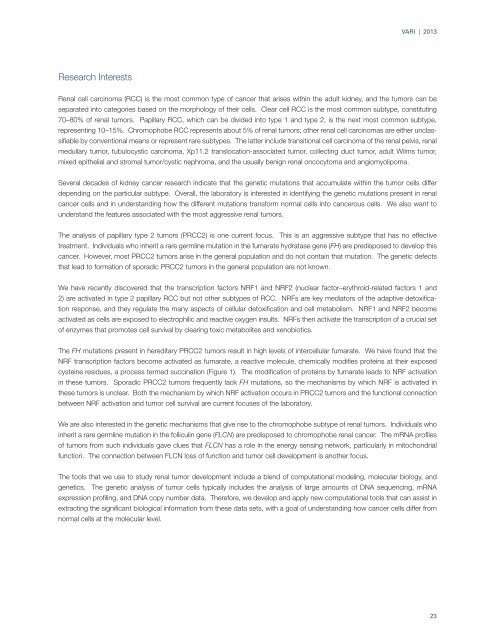2013 Scientific Report
Create successful ePaper yourself
Turn your PDF publications into a flip-book with our unique Google optimized e-Paper software.
VARI | <strong>2013</strong><br />
Research Interests<br />
Renal cell carcinoma (RCC) is the most common type of cancer that arises within the adult kidney, and the tumors can be<br />
separated into categories based on the morphology of their cells. Clear cell RCC is the most common subtype, constituting<br />
70–80% of renal tumors. Papillary RCC, which can be divided into type 1 and type 2, is the next most common subtype,<br />
representing 10–15%. Chromophobe RCC represents about 5% of renal tumors; other renal cell carcinomas are either unclassifiable<br />
by conventional means or represent rare subtypes. The latter include transitional cell carcinoma of the renal pelvis, renal<br />
medullary tumor, tubulocystic carcinoma, Xp11.2 translocation-associated tumor, collecting duct tumor, adult Wilms tumor,<br />
mixed epithelial and stromal tumor/cystic nephroma, and the usually benign renal oncocytoma and angiomyolipoma.<br />
Several decades of kidney cancer research indicate that the genetic mutations that accumulate within the tumor cells differ<br />
depending on the particular subtype. Overall, the laboratory is interested in identifying the genetic mutations present in renal<br />
cancer cells and in understanding how the different mutations transform normal cells into cancerous cells. We also want to<br />
understand the features associated with the most aggressive renal tumors.<br />
The analysis of papillary type 2 tumors (PRCC2) is one current focus. This is an aggressive subtype that has no effective<br />
treatment. Individuals who inherit a rare germline mutation in the fumarate hydratase gene (FH) are predisposed to develop this<br />
cancer. However, most PRCC2 tumors arise in the general population and do not contain that mutation. The genetic defects<br />
that lead to formation of sporadic PRCC2 tumors in the general population are not known.<br />
We have recently discovered that the transcription factors NRF1 and NRF2 (nuclear factor–erythroid-related factors 1 and<br />
2) are activated in type 2 papillary RCC but not other subtypes of RCC. NRFs are key mediators of the adaptive detoxification<br />
response, and they regulate the many aspects of cellular detoxification and cell metabolism. NRF1 and NRF2 become<br />
activated as cells are exposed to electrophilic and reactive oxygen insults. NRFs then activate the transcription of a crucial set<br />
of enzymes that promotes cell survival by clearing toxic metabolites and xenobiotics.<br />
The FH mutations present in hereditary PRCC2 tumors result in high levels of intercellular fumarate. We have found that the<br />
NRF transcription factors become activated as fumarate, a reactive molecule, chemically modifies proteins at their exposed<br />
cysteine residues, a process termed succination (Figure 1). The modification of proteins by fumarate leads to NRF activation<br />
in these tumors. Sporadic PRCC2 tumors frequently lack FH mutations, so the mechanisms by which NRF is activated in<br />
these tumors is unclear. Both the mechanism by which NRF activation occurs in PRCC2 tumors and the functional connection<br />
between NRF activation and tumor cell survival are current focuses of the laboratory.<br />
We are also interested in the genetic mechanisms that give rise to the chromophobe subtype of renal tumors. Individuals who<br />
inherit a rare germline mutation in the folliculin gene (FLCN) are predisposed to chromophobe renal cancer. The mRNA profiles<br />
of tumors from such individuals gave clues that FLCN has a role in the energy sensing network, particularly in mitochondrial<br />
function. The connection between FLCN loss of function and tumor cell development is another focus.<br />
The tools that we use to study renal tumor development include a blend of computational modeling, molecular biology, and<br />
genetics. The genetic analysis of tumor cells typically includes the analysis of large amounts of DNA sequencing, mRNA<br />
expression profiling, and DNA copy number data. Therefore, we develop and apply new computational tools that can assist in<br />
extracting the significant biological information from these data sets, with a goal of understanding how cancer cells differ from<br />
normal cells at the molecular level.<br />
23

















